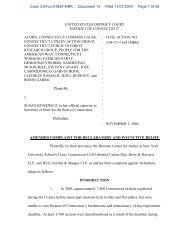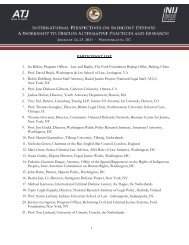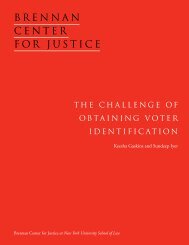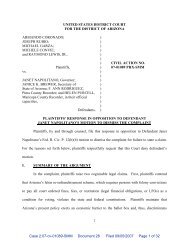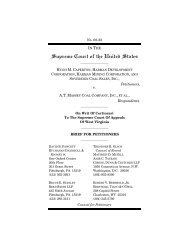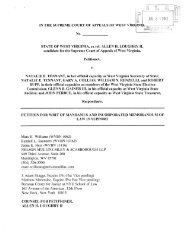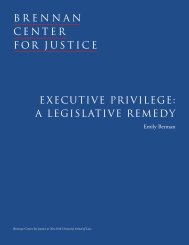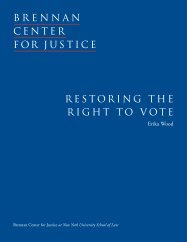THE NEW YORK STATE LEGISLATIVE PROCESS: AN ...
THE NEW YORK STATE LEGISLATIVE PROCESS: AN ...
THE NEW YORK STATE LEGISLATIVE PROCESS: AN ...
Create successful ePaper yourself
Turn your PDF publications into a flip-book with our unique Google optimized e-Paper software.
64 <strong>THE</strong> <strong>NEW</strong> <strong>YORK</strong> <strong>STATE</strong> <strong>LEGISLATIVE</strong> <strong>PROCESS</strong>: <strong>AN</strong> EVALUATION <strong>AN</strong>D BLUEPRINT FOR REFORM<br />
79 JOH<strong>AN</strong>NA M. DONLIN & BRI<strong>AN</strong> J. WEBERG, NAT’L COUNCIL OF <strong>STATE</strong> LEGISLATURES,<br />
<strong>LEGISLATIVE</strong> STAFF SERVICES: PROFILES OF <strong>THE</strong> 50 <strong>STATE</strong>S <strong>AN</strong>D TERRITORIES 2 (1999).<br />
80 AL<strong>AN</strong> ROSENTHAL, <strong>THE</strong> DECLINE OF REPRESENTATIVE DEMOCRACY 139 (1998).<br />
81 COUNCIL ON <strong>STATE</strong> GOVERNMENTS, BOOK OF <strong>THE</strong> <strong>STATE</strong>S 158 tbl.3.22 (2003) [hereinafter<br />
BOOK OF <strong>THE</strong> <strong>STATE</strong>S].<br />
82 The legislative director for one Assembly member notes that it is the committee staff members<br />
who “propose the committee meeting agenda to the Chair, who then approves the agenda.”<br />
E-mail Correspondence from B, Legislative Director for N.Y. Asssemblymember C (Oct. 10, 2003)<br />
(on file with the Brennan Center).<br />
83 Telephone Interview with B, Legislative Director to N.Y. State Assembly Member C, Oct.<br />
10, 2003; E-mail Correspondence from N.Y. State Sen. D (Oct. 21, 2003) (on file with the Brennan<br />
Center).<br />
84 Telephone Interview with B, Legislative Director to N.Y. State Assembly Member C, Oct.<br />
10, 2003.<br />
85 BOOK OF <strong>THE</strong> <strong>STATE</strong>S, supra note 81, at 160 tbl. 3.23. Connecticut, Maine, and<br />
Massachusetts were not included in these comparisons because those three states use a joint committee<br />
system that is not directly comparable to that of New York.<br />
86 See Congressional Committee Listings, at http://www.house.gov/house/Committee<br />
WWW.html (last visited Jan. 14, 2004) & http://www.senate.gov/pagelayout/committees/<br />
d_three_sections_with_teasers/committees_home.htm, (last visited Jan. 14, 2004).<br />
87 As Alan Rosenthal notes: “The more committees, the more opportunities for chairmanships.<br />
It is not unusual, therefore, for committees to proliferate during a tight race for leadership,<br />
when rivals make promises in return for support, or in an effort by an incumbent leader to consolidate<br />
his or her position.” ROSENTHAL, supra note 80, at 134. Section 5 of the Legislative Law establishes<br />
the uniform annual salary of all legislators ($79,500), N.Y. LEG. § 5, but that is just the baseline<br />
for members’ compensation. Section 5-a, which is amended every two years, provides a<br />
“schedule” of special “allowances” for members who serve in various official special capacities.<br />
The Senate includes 61 Senators; there are 87 special allowances for those Senators. The Assembly<br />
includes 150 members; there are 116 special allowances for those members. No legislator may<br />
receive more than one special allowance at any time, so all Senators and very nearly all Assembly<br />
members receive some kind of special allowance above and beyond their base salaries. See N.Y.<br />
LEG. § 5-a(2)(a).<br />
88 Winnie Hu, Legislature’s Second Fiddles Take Lead Roles in Budget Fight, N.Y.TIMES, May 19,<br />
2003, at B1.<br />
89 John J. Pitney Jr., Leaders and Rules in the New York State Senate, 7 LEGIS. STUD. Q. 491, 494<br />
(1982) (citing Peter A. Berle, DOES <strong>THE</strong> CITIZEN ST<strong>AN</strong>D A CH<strong>AN</strong>CE? 31-32 (1974)).<br />
90 See N.Y. ASSEMB. R. I, § 1(c)(3) (“The Speaker … shall appoint the chairpersons and members<br />
of all committees thereof, except where the House shall otherwise order[.]”); N.Y. SEN. R. II,<br />
§ 2 (“[The majority leader] shall appoint . . . the chair, vice-chair and members of all committees<br />
and sub-committees, except when the Senate shall otherwise order.”). The speaker plays a major<br />
role in appointing members of committees in 44 (of 49) state houses and appointing committee<br />
chairs in 43 (of 49) state houses. State senates are more divided. In 10 (of 50, including New York)<br />
states, the president pro tem has member and chair appointment power, though New York is the<br />
only state in this group where the president pro tem is also the majority leader. In five other states,<br />
the majority leader possesses such appointment powers. The senate president (in four cases, the<br />
same as the lieutenant governor) has the power to appoint members in 19 (of 50) senates and chairs<br />
in 18 (of 50) senates. BOOK OF <strong>THE</strong> <strong>STATE</strong>S, supra note 81, at 160 tbl 3.23. Hamm and Hedlund<br />
provide a more anecdotal perspective: “In more than two-thirds of the 99 state legislative cham-



